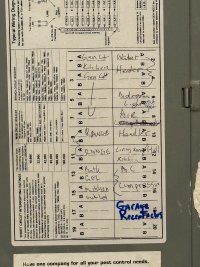The National Electrical Code (NEC) requires every circuit to be identified clearly and permanently. Section 408.4 of the 2023 NEC makes this point unambiguous. Whether it is a switchboard, switchgear, or the panelboard inside a single-family home, the rule is the same: every breaker or switch must be described in a way that leaves no room for confusion.
Would this be compliant?

The Rule Itself
408.4(A) requires:- A legible, permanent description for every circuit or modification.
- The description must appear at the breaker itself or in a directory on, inside, or adjacent to the panel door.
- Each circuit must be identified with enough clarity that its purpose is immediately understood.
- Even spare breakers with no connected load must be marked as spares.
- Descriptions cannot be tied to temporary or changing conditions, such as the current occupant’s name.
- Abbreviations and symbols must be explained so they are understandable to anyone reading the directory.
Why This Matters
This isn’t about paperwork, it is about safety. A circuit directory is more than just a convenience—it can be a lifesaving tool. When an emergency responder, service technician, or even a homeowner needs to act quickly, they cannot afford to guess which breaker shuts off the kitchen outlets or the HVAC system. Mislabeling or vague entries can cause delays and hazards.Common Mistakes
The NEC makes it clear that generic labels like “lights” or “outlets” do not meet the standard. Those descriptions fail because they do not pinpoint which lights or outlets are controlled by the breaker. For example:- Not acceptable: “Kitchen small appliance circuit.”
- Acceptable: “Kitchen countertop receptacles, left of sink.”
Spare Breakers
Another point often overlooked is the requirement to mark unused overcurrent devices. Even if a breaker is not connected to anything, it cannot remain unmarked. Labeling them as “spare” prevents someone from assuming it is available for use without verification.Permanent, Not Temporary
Circuit descriptions must reflect permanent building features, not temporary occupants or uses. A breaker cannot be labeled with an employee’s name (“John’s Office”) because that information becomes meaningless when John leaves or the office use changes. Instead, it should read “Northeast office receptacles” or something equally tied to the physical space.Residential Application
It is important to note that this section applies not only to large commercial switchgear but also to the panelboards found in every single-family dwelling. Homeowners often treat circuit directories casually, scribbling vague or outdated notes on the inside of the panel door. The NEC requires better. Clear, durable labeling is just as necessary in a home as it is in a commercial building.Takeaway
NEC 408.4 sets a straightforward expectation: circuit directories must be specific, permanent, and understandable. Whether you are an installer, inspector, or building owner, compliance ensures the electrical system is not only code-compliant but also safe and functional for anyone who may need to operate it.Would this be compliant?

Last edited:
